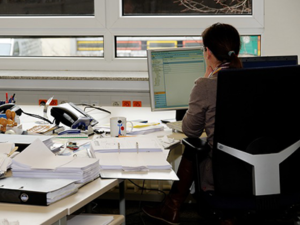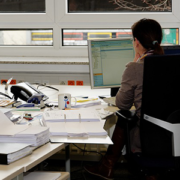Assessing and Managing Operational and Investment Risk: glasshammer2.wpengine.com Seminar for Senior Women on the Buy-Side
 Theglasshammer.com hosted the first in the series of invitation-only networking seminars for senior women on the Buy-Side at the Harvard Club in New York City on September 29th. Our intent: to create a peer-to-peer environment for CEOs, Principals and Managing Directors of traditional and alternative funds to enable them to interact with Chief Operating Officers, Chief Technology Officers, Heads of Risk Management, and Heads of Operations and discuss the how the industry has changed over the past two years. The result: 100 female leaders in investment management gathered to network and to hear Cynthia Steer, Chief Strategist of Rogerscasey, Marianne Brown, CEO of Omgeo, Liz Philipp, head of the NY office for PIMCO and Annie Morris, Head of Linedata’s North American Business weigh in on the predicted trends for the industry.
Theglasshammer.com hosted the first in the series of invitation-only networking seminars for senior women on the Buy-Side at the Harvard Club in New York City on September 29th. Our intent: to create a peer-to-peer environment for CEOs, Principals and Managing Directors of traditional and alternative funds to enable them to interact with Chief Operating Officers, Chief Technology Officers, Heads of Risk Management, and Heads of Operations and discuss the how the industry has changed over the past two years. The result: 100 female leaders in investment management gathered to network and to hear Cynthia Steer, Chief Strategist of Rogerscasey, Marianne Brown, CEO of Omgeo, Liz Philipp, head of the NY office for PIMCO and Annie Morris, Head of Linedata’s North American Business weigh in on the predicted trends for the industry.
The panel represented a 360-degree view of industry issues from front office to back office and how the “New Normal” means that operational risk is now a primary concern for business leaders who want to continue to compete in 2010 and beyond. Inspired by thought provoking questions posed by moderator Holly Miller of Stone House Consulting, the panelists first addressed the issue of operational due diligence, emphasizing the importance of having a corporate culture which supports a consistent due diligence effort.
“There has been a revolution over the last two years,” said Steer, “[People are recognizing that] you need to read your prospectuses; you need to ‘do’ back office.”
Assessing and Managing Operational and Investment Risk
Miller said that when she was first starting out in the industry, when people talked about risk management, they were talking about investment risk rather than operational risk; she asked the panelists how things are changing in terms of managing and defining risk. Philipp spoke of the “new normal”: “[Assessing and managing operational risk is] something that I think many people took for granted before 2008. Any smart portfolio manager…now makes sure that operational risk and legal risk are under control and that they have a good handle on it…It has to be part of the firm’s culture. That is something that can be the basis for higher fees, higher peace of mind.”
“You can divide the world between bond geeks and equity geeks,” said Steer. “The optimists tend to be the guys in the equity world. They think the world is reverting back to their normal. It is not. Women (even if they are in an equity shop) know it is something different. So I think it is a real journey. It takes a little while for people to understand we really are in a ‘new normal’ – quantitatively, qualitatively, any way you want to make it. And even if we have returns that look like the ‘old normal,’ it ain’t the ‘old normal.’ So this is a transition philosophically, in process, in risk process, in budgeting and in risk.”
Said Brown, “This crisis will represent a change in the collective DNA up to and inclusive of the perception of performance, expectation of returns, and truly embracing a risk-reward that is surely more of an art than a science.”
Steer added that there is another challenge: “Unlike any other time I know of, [investors] have to de-risk the portfolio simultaneously with re-risking. That is a pretty difficult thing [because] you have to be able to define de-risking to get at re-risking. I think people are caught up in all parts of the spectrum trying to understand and those who didn’t have liquidity in 2007 and 2008 are playing philosophical catch up.”
Panelists across the board stressed the importance of hands-on management as well as developing a deep understanding of the issues. “We use our tools and know how to manipulate the tools but don’t understand the risk underneath it and how to calculate it ourselves,” said Steer. “Women need to be confident and have to have mastery before they take risk in general…We’ve got to get to the point where we understand it so then we can define the risks…and be valuable to our clients.”
Miller warned, “Don’t rely on compliance departments and attorneys…[you need to] know what is in your contracts. Your attorneys don’t necessarily get all the operations issues. Many of them are very good but they don’t know the piece you do as well as you do.”
Panelists also emphasized the importance of buy-in from the top of an organization on new initiatives, especially those involving operations and/or technology. Morris explained, “If there is executive-level sponsorship for the success of [any] project, the project is going to go well. If it is not a priority [for management], those projects are probably those that end up where [the firm] is not happy with the final result. It comes down to education. This is something that many executive sponsors don’t understand – it is not part of their day, it is not going to help them raise assets. But, from a technology perspective, to make those projects successful, the partnership and involvement in the front office [is key].”
Industry Leadership: Obligations and Opportunities
Some audience members expressed concern about regulations likely to be handed down by politicians without the necessary industry expertise. The panelists acknowledged the challenge, stating that it is up to industry experts to stand up and have their voices heard.
“I believe that our industry is at a crossroads when it comes to where we are going to go with the operational structures for sustainability. In a way, as leaders in this industry, we need to take it upon ourselves to provide that education to the market,” said Morris.
Brown added, “It is critical to remember that market participants have the necessary expertise to help drive regulation that works best for market participants. There is an opportunity for us to take a breath and say ‘let’s lead the change, let’s have the dialogue and let’s raise the noise level of our dialogue.’ Today it’s about collaboration between market participants and regulators to ensure that meaningful change is achieved.”
“Regulation is way too often done looking in the rear view mirror,” said Philipp. “What is different now though is that the government is a market participant. They have a vested interest going forward in getting it right. They are consulting the market players this time because they are one of them.”
Said Miller,“[The current crisis and resulting challenges] are an opportunity as well as an obligation. Many firms are taking the opportunity to renegotiate contracts at prices better than they got two years ago. Now is a great time to do [that] because you can get a lot of really great people at half the price you were [able to] before.”
Women on the Buy-Side: Leaders of the Pack from Glass Hammer on Vimeo.
Please be sure to complete our survey on Trends in Investment Management (link on the sidebar).
CONTACT nicki@theglasshammer.com to be invited to the next event
By Pamela Weinsaft and Nicki Gilmour




I appreciate the summary of this conference, which I was unable to attend. I am a consultant working with microlenders (and multilateral lending institutions) on issues of risk management in the microfinance sector and we are having the exact same discussions, especially regarding the need to focus on operational risk, get senior management buy in and educate regulators.
I also used to work as a risk manager with a large universal bank and can attest that risk management was not well appreciated – it was considered a cost rather than an investment. Hopefully the lessons of the past year or so have changed that perspective.